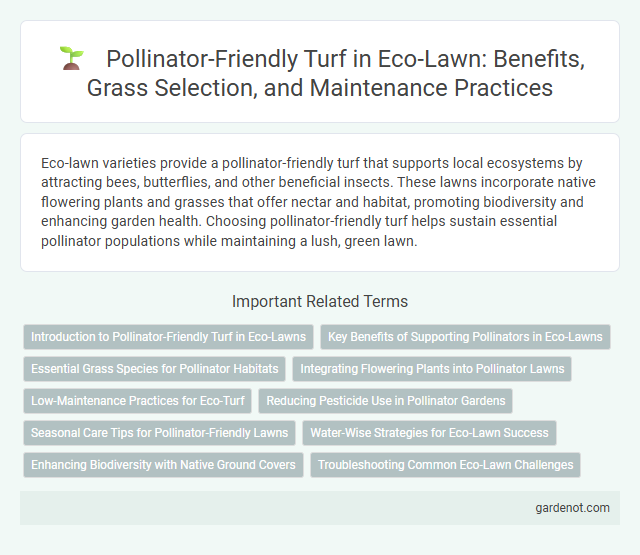Eco-lawn varieties provide a pollinator-friendly turf that supports local ecosystems by attracting bees, butterflies, and other beneficial insects. These lawns incorporate native flowering plants and grasses that offer nectar and habitat, promoting biodiversity and enhancing garden health. Choosing pollinator-friendly turf helps sustain essential pollinator populations while maintaining a lush, green lawn.
Introduction to Pollinator-Friendly Turf in Eco-Lawns
Pollinator-friendly turf in eco-lawns incorporates native flowering plants and grasses that provide essential habitat and nectar sources for bees, butterflies, and other pollinators. This type of turf supports biodiversity by promoting healthy ecosystems and reducing the need for chemical fertilizers and pesticides commonly used in traditional lawns. Implementing pollinator-friendly turf enhances environmental sustainability and contributes to the conservation of vital pollinator populations.
Key Benefits of Supporting Pollinators in Eco-Lawns
Pollinator-friendly turf in eco-lawns enhances biodiversity by providing essential habitats for bees, butterflies, and other beneficial insects, boosting local ecosystems. Supporting pollinators increases plant pollination efficiency, which improves grass health and resilience against pests and diseases. Eco-lawns with pollinator-friendly turf contribute to sustainable landscaping by reducing chemical use and promoting natural pest control, leading to long-term environmental benefits.
Essential Grass Species for Pollinator Habitats
Pollinator-friendly turf relies on essential grass species such as fescues (Festuca spp.), Kentucky bluegrass (Poa pratensis), and buffalograss (Bouteloua dactyloides) that support diverse pollinator habitats by providing shelter and foraging opportunities. Fine-leaved fescues enhance soil health and nectar availability, while native species like buffalograss improve drought tolerance and pollen sources for bees and butterflies. Incorporating these grasses into eco-lawns promotes biodiversity and strengthens pollinator populations critical for ecosystem balance.
Integrating Flowering Plants into Pollinator Lawns
Integrating flowering plants such as clover, self-heal, and wild violets into pollinator-friendly eco-lawns enhances biodiversity and supports vital pollinator populations like bees and butterflies. These flowering species provide essential nectar and pollen resources, improving ecosystem health and resilience. Selecting native, low-maintenance plants optimizes soil quality and reduces water consumption while creating vibrant, sustainable turf environments.
Low-Maintenance Practices for Eco-Turf
Pollinator-friendly turf incorporates native wildflowers and grasses that support honeybees, butterflies, and other beneficial insects while requiring minimal watering and mowing. Low-maintenance practices for eco-turf include organic fertilization, reduced chemical use, and mowing at higher grass heights to promote deeper root growth and longer flowering periods. These methods enhance biodiversity, improve soil health, and sustain pollinator habitats with less environmental impact.
Reducing Pesticide Use in Pollinator Gardens
Pollinator-friendly turf minimizes pesticide use by incorporating native grasses and flowering plants that support bees, butterflies, and other beneficial insects. Reducing chemical inputs in these eco-lawns enhances biodiversity and promotes a healthier, balanced ecosystem. Sustainable maintenance practices such as organic fertilization and integrated pest management further protect pollinators while maintaining turf health.
Seasonal Care Tips for Pollinator-Friendly Lawns
Seasonal care for pollinator-friendly turf involves maintaining diverse native flowering grasses and minimizing chemical use to support bee and butterfly populations. In spring, mow high and leave flower-rich patches intact to encourage early blooms, while summer watering is kept moderate to avoid stressing native plants. Autumn calls for overseeding with native wildflowers and reducing fertilizer input to prepare the lawn for overwintering pollinators.
Water-Wise Strategies for Eco-Lawn Success
Pollinator-friendly turf enhances biodiversity by supporting bees, butterflies, and other vital pollinators, promoting ecosystem health. Incorporating drought-resistant grass species and native plants reduces water consumption while maintaining lush, resilient lawns. Efficient irrigation methods like drip systems and rainwater harvesting optimize moisture retention, ensuring sustainable growth for eco-lawns.
Enhancing Biodiversity with Native Ground Covers
Pollinator-friendly turf consisting of native ground covers supports local ecosystems by providing essential nectar and habitat for bees, butterflies, and other pollinators. These native plants enhance biodiversity by attracting a diverse range of pollinating species, improving soil health, and reducing the need for chemical fertilizers and pesticides. Integrating native ground covers in eco-lawns fosters resilient landscapes that promote ecological balance and sustain pollinator populations.
Troubleshooting Common Eco-Lawn Challenges
Pollinator-friendly turf in eco-lawns often faces challenges such as weed invasion, poor soil quality, and inconsistent moisture levels that can hinder plant health and pollinator activity. Addressing soil pH imbalances through regular testing, using organic mulches, and implementing targeted watering schedules enhances turf resilience and supports pollinator habitats. Integrated pest management techniques reduce harmful chemical use while maintaining the ecological balance essential for thriving pollinator-friendly lawns.
Pollinator-friendly turf Infographic

 gardenot.com
gardenot.com